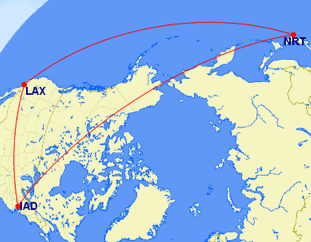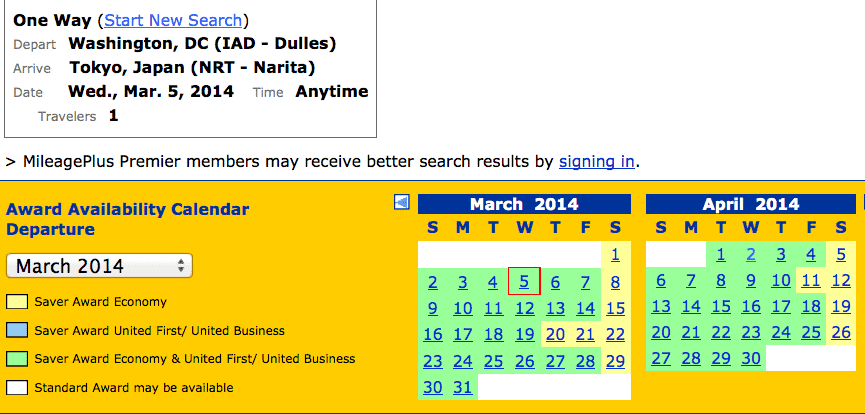MileValue is part of an affiliate sales network and receives compensation for sending traffic to partner sites, such as CreditCards.com. This compensation may impact how and where links appear on this site. This site does not include all financial companies or all available financial offers. Terms apply to American Express benefits and offers. Enrollment may be required for select American Express benefits and offers. Visit americanexpress.com to learn more.
Note: Some of the offers mentioned below may have changed or are no longer be available. You can view current offers here.
Deborah writes:
Goal: I want to start planning for a trip to Japan. My home airport is Washington-Dulles. Assuming I am starting from scratch, for which airline does it make most sense to start collecting miles?
So which program is best from the east coast to Japan? My advice and reasoning after the jump.
I would definitely focus on United miles if I were Deborah. The reasons are manifold:
1) There are two direct flights from Washington-Dulles to Tokyo-Narita daily that you can use United miles to fly–one on United and one on partner ANA.
They both have incredible award availability. Here’s the March-April 2014 availability on direct flights. Green days have award space in economy and a premium cabin that day. Yellow days have award space only in economy.
You might think that connecting on the west coast wouldn’t add much flying time, but connecting in Los Angeles actually would add at least 2:30 of flying time plus layovers to your trip because the direct path from DC to Tokyo isn’t west. It’s north.

If space isn’t available on the direct flight, you can also connect in Newark on a United flight or New York-JFK on an ANA flight. Both of these routings are more convenient than connecting west of Washington DC.
2) United has a world class business class product. I think this fact is under-reported because United doesn’t have an aspirational first class product.
United business class isn’t fancy, but the bed is a very comfortable flat bed that will let you arrive refreshed. Most beds that are this comfortable have far worse award space. Here are two reviews of United BusinessFirst as it’s called–one from the perspective of someone who has flown competing products and one from a first timer in a premium cabin.
3) United-parnter ANA has an extensive intra-Japan network with plenty of award space.
4) United roundtrip awards allow a stopover anywhere en route if you want to see somewhere else or break up the trip.
If not, take that stopover at your home airport thereby creating the opportunity for a free oneway!
5) Thai Airways (a United partner) just started flying from Osaka to LAX several times a week with amazing award availability and an incredible flat bed business class.
This route presents a great opportunity to try a premium business class, use an open jaw to return from Osaka or fly via the west coast for a stopover one direction.
How Many Miles Do You Need
United charges 32.5k/60k/70k each way per person in economy/business/first to Japan.
That means two people will need between 130k and 280k total miles depending on the cabin they want to fly. And you can mix-and-match cabins freely, for instance going one direction in economy and one in business for 92.5k miles each or 185k miles total.
Recap
For east coasters looking to get to Japan, I strongly recommend accruing United miles for the better routings, great business class product, excellent availability, and ease of accruing the miles.




I am pretty new to mile collecting and hope to fly to Europe and stay at some hyatts in 2014 so want as many United/UR points as possible! It seems the United cc is not recommended by you and others . . . Is the 30,000 miles rewarded low and that is why not recommended for accruing miles? I have the Chase SP and planning on applying for Ink in July and could apply for united . . . Or should I wait for a better offer? Thanks
@BFD, depending if you live on the east coast, you might want to check out the Chase British Airways Visa. Where in Europe did you want to go?
I wouldn’t recommend the BA Visa for Europe unless you want to fly airberlin or Aer Lingus economy and you live in NYC or a few other places.
There is still a 55k offer out there for United. You can find the thread and directions on Flyertalk. It works just got mine last month.
I wouldn’t get the 30k offer. Tom, below, says there is a 55k card out there, which would be better than the Sapphire Preferred if you can get that targeted offer.
Can’t disagree with the reasoning and going with Star Alliance, but given that US Airways has access to all the same space, and this being an award chart sweet spot for US Airways, why the nod to United?
@Jason, probably because of the upcoming merger US/AA merger. It takes at least some time to accumulate even just 130k miles, let alone 240k, and there are fewer opportunities both to transfer card points to USDM and also to earn USDM on signups. There is no clear timetable for when US miles will no longer be usable for Star Alliance carriers, but it *could* be fewer than 12 months away. That’s a mighty short interval to get the miles with enough lead time to actually get the award space you want.
Great point, but how to get 60k/90k/120k US Airways miles easily? The only options are the US Airways card and SPG cards, none of which have a big sign up bonus or good categories. But yes, if you can get 90k US Airways miles, that would be better than using 120k United miles. (I am going to miss the US Airways chart!)
The CC links in your post no longer work
Fixed. Thanks
I am actually thinking of flying from JFK to TYO with my wife on December 27, 2013 on AA and then return with most likely Lufthansa (found on United’s website). The first one, not only is it direct but also it costs only 25,000 miles plus $2.50 in fees pp. Worth mentioning is the fact, that we’d be getting back some 10% miles credit, as per Citi/AA’s regulations 🙂